Lost Wax Casting
This is a little photographic tour of my lost wax casting process. It is a mix of photos I have taken throughout the years - some probably look a bit on the funny side due to funky filters when I first got an iphone (that lets you know just how old some of these are!). It is a pretty detailed though brief tutorial for those interested in doing their own lost wax casting, and it also gives a look at how much work goes in to each ring. All of my waxes are made individually. I really enjoy working with softer waxes. I've used hard waxes for some things when needed, but they aren't my favorites. I've made several of my own tools and have repurposed tools from my ceramics class. I also have a couple sets of really nice Kate Wolf tools - those tend to work better for hard, carving waxes.


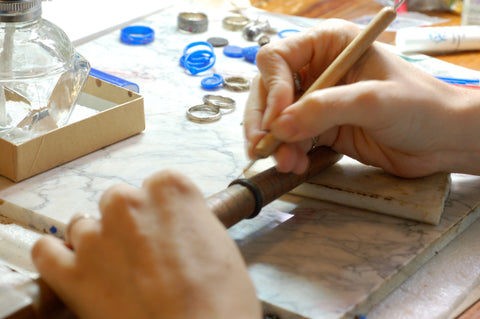
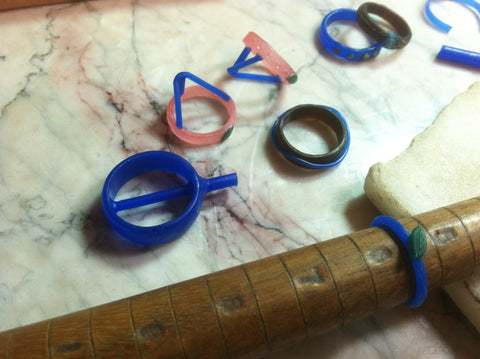
Spruing allows the wax to melt out of the mold during burnout (see below) and for the metal to get to your piece when casting - not having enough sprues or having them in an improper location can cause your piece to not turn out if the molten metal cannot adequately flow to all areas of the piece. After all sprues have been attached it is now time to weigh the waxes.
This is very important and is often forgotten: The weight of the wax is used to determine how much metal you will need for the casting. Because each metal has a unique specific gravity - you will need to know that number and multiply by your wax weight. I use this chart from Hoover and Strong.


After the waxes are weighed, it's time to attach them to the sprue base or button. Then the flask is lowered over the waxes. As a rule of thumb, you should leave at least 1/4" of space between the edge of the flask and the waxes. I've pushed it and nothing bad has happened, but that doesn't mean that it won't. You can have a blow out where the hot molten metal breaks through because there was not enough investment. The same is true with the top of the flask; if the wax is too close to the top, the metal could break right through. And for vacuum casting, this could be a costly mistake as the metal would most likely damage your casting table. Though from experience the investment just gets sucked off and the mold ruined before you even have a chance to cast. Also, with vacuum casting, there needs to be at least 1/8th" of space between the top of the investment and the top of the flask - so make sure to not have the waxes too close to the top of the flask. Centrifugal casting is a little different and you can build the investment up if you need to.
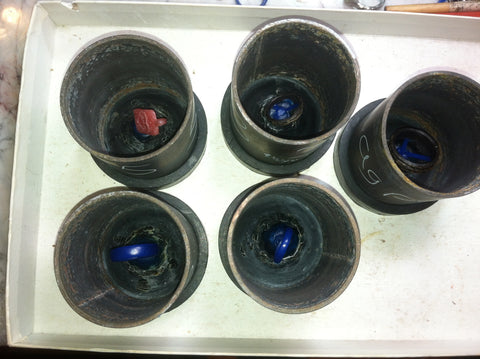
Now you are ready to invest! You need to know the size of your flask and how much investment you will need. For the smallest and cutest flasks I use, 4 = 1lb (or each one is 1/4lb). Measure the water out first and pour it in a rubber mixing bowl. Now weigh out the investment. Investment contains silica - so you should wear a dust mask or respirator if you don't have a really good exhaust system. The photo below is not what I call "really good exhaust" and I do have something a little nicer now.
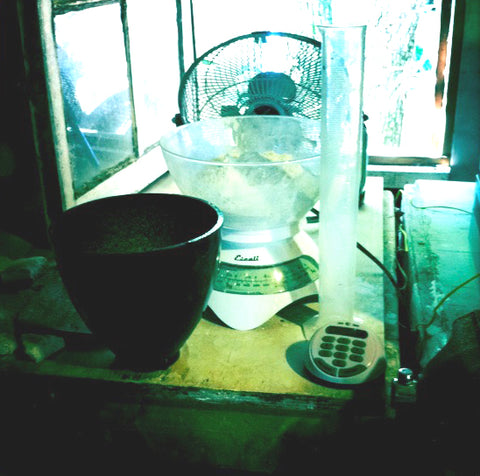
Set the timer for 8 minutes. This is the longest that your investment should be disturbed. Once it starts setting up, you don't want to be messing with it. I start the timer and then pour the investment in to the water.
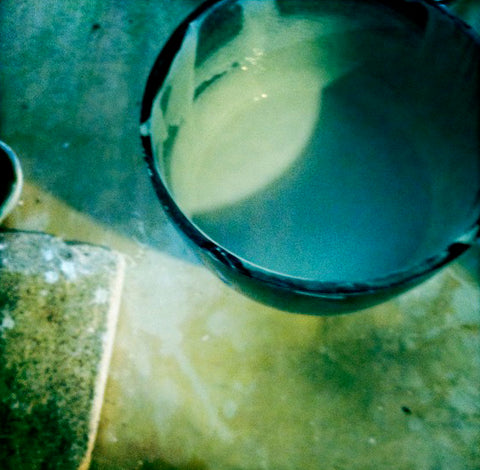
Mix for 3 minutes - when it turns to 5 min, it's time to vacuum.
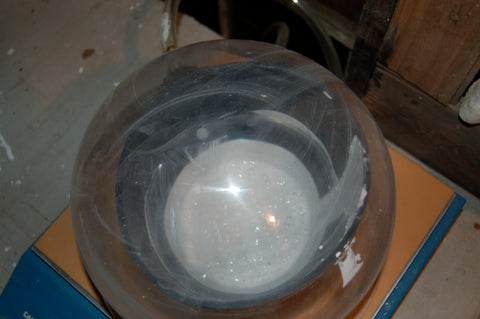
Vacuum the investment for 2 min - this is the first step in vacuuming. Bubbles are good - this is the vacuum getting all the air out of the investment. It will "boil" up and you need to vacuum for at least 20 sec after that, 2 min total is best though.

Now, pour the investment in to the flask. It's a good idea to have tape around the top of your flask to keep the investment from bubbling over and making a huge mess. When pouring, pour down the edge of the flask, not directly on the waxes as it could cause the wax to move slightly and perhaps against another wax or too close to the edge.
Now for the vacuuming of the flask! If you are vacuuming more than one flask of the same size, make sure to mark them. I use a piece of chalk to write a number corresponding to the wax weights - the chalk doesn't burn off in the kiln so its easy to distinguish when getting them quickly. Vacuuming removes air that might have been trapped around the waxes and still in the investment from pouring - vacuum for approx 1.5 minutes - don't go over your 8 minutes. It bubbles up and over like an ancient tar pit! The rings were pretty small in this flask, so I didn't fill it up all the way to reduce the bubbling over. If there was a little bit of investment left over after the time is up, you can pour the little bit on top. (Reminder: With vacuum casting, you need to leave at least 1/8th" at the top to aid in the suction during the casting. If doing centrifugal casting, it can go over the top of the flask.)
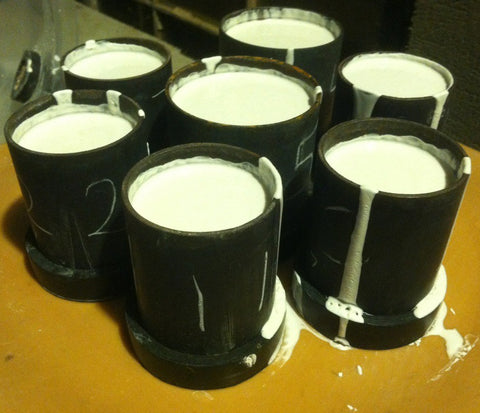
Now it needs to sit for about 10 - 15 minutes undisturbed until it sets up, then it needs to sit for about 1.5 - 2 hours before you can start the burnout process in the kiln. (Unless you are doing the super fast burnout, but that is a whole other story.) If there are any drips on the top, clean those up before putting them in the kiln so they will sit flush when casting.
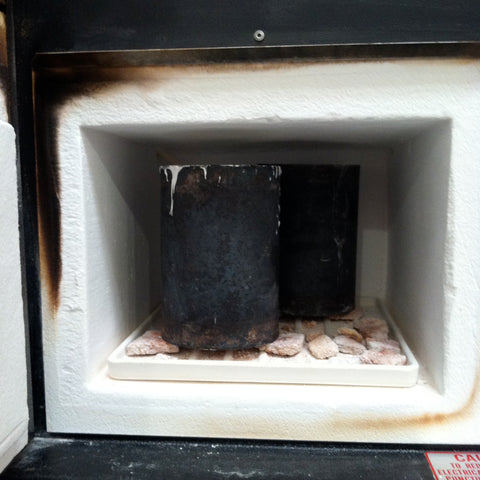
Once the flask is ready - it goes in the kiln and starts the burnout process. Burnout times are anywhere from 2.5 - 12 hours. The 5 hour burnout is perfect for doing just a few smaller flasks. My ramping schedule looks like: Hour 1: 300 degrees, Hour 2: 700 degrees, Hour 3 and 4: 1350 degrees, Hour 5: 1000 degrees - and hold. Hold temperature may vary depending on the metal. For larger flasks, larger waxes, natural materials or a really full kiln, up to a 12 hour burnout.

Once the kiln has been at the holding temp for an hour, it's time to start heating up the crucible and the metal.

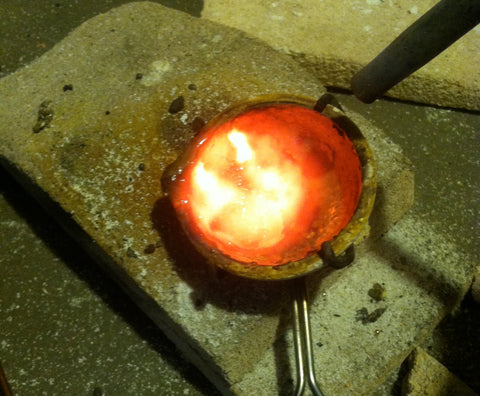
Make sure the crucible is red hot before adding the metal.

Once the metal has melted, give it a pinch of flux, a stir with a carbon stirring rod (and make sure to heat it up first or the metal will stick to it) I came up with a special design of fire bricks to hold the torch or torches... With my hands free, I can get the flask out of the kiln.

Make sure to check to see that the pathways are clear - if burning out natural material, some ashes might be stuck. You can check it before you start melting the metal if you think there might be an issue you'd need to clear up, otherwise, a quick check on the way to the casting table is just fine.

Also note the giant fireproof glove. I wish they made them in smaller sizes!

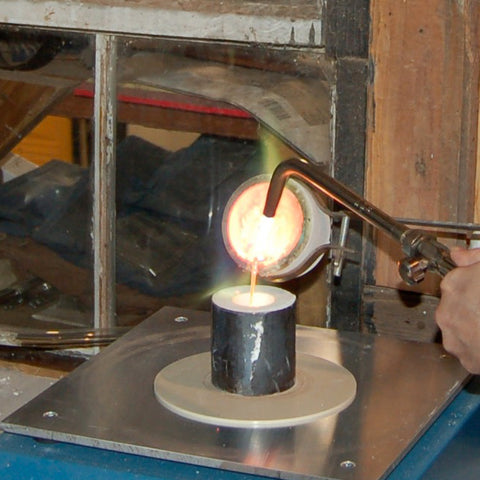
Place the flask upside down on the casting table (same as investing table, just make sure the toggle switch is flipped to "Cast") with the holes facing up. Turn on the vacuum pump. Position the crucible over the flask - make sure to always keep the torch on the metal. Removing the torch can cause oxygen to get in and that is bad. These photos show a larger style of crucible I used to use. I now have the little whip handles that are much better for small quantities of metal and ease of pouring. As you are pouring, keep the torch on the metal and pour quickly. Pouring too slowly or moving the torch can cause the metal to freeze up and your casting won't work. Once the metal is poured, turn off the torch and the vacuum pump. Release the vacuum by flipping the toggle off of cast and move the flask away to let it cool.
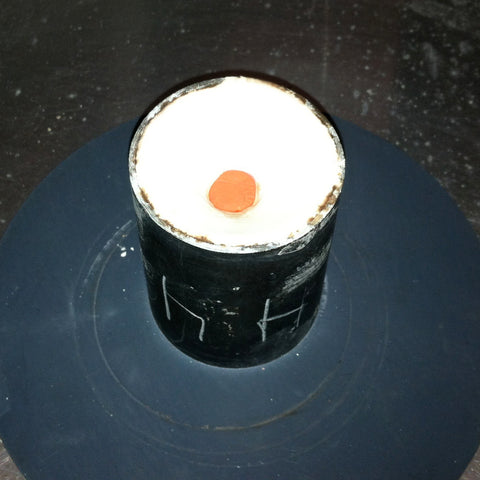

Wait until the metal is no longer red hot. I check it under a dark area of the table before quenching.

Now that the metal has cooled a bit and it is time to quench - this will vary depending on the metal used. Make sure the flask is completely under the water. You want it to all be bubbling completely underneath the surface of the water. (The above is an example of not being completely under the water. Don't do this.) If you have used cast in place stones or some alloys you don't want to quench when the metal is hot. You need to let some completely cool - an hour or so as to not crack the stones or cause the metal to be shocked. Regular sterling is fine to quench after a few minutes.
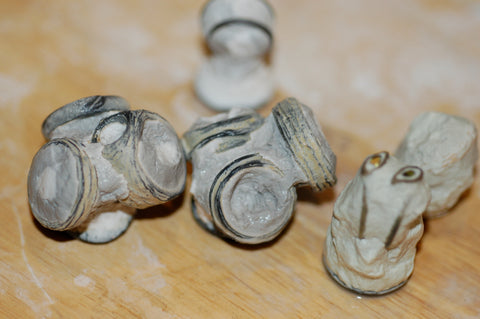
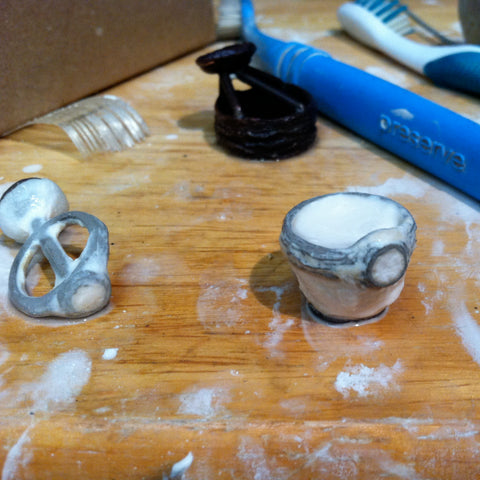
This is what the pieces look like right out the flask completely caked with the investment.
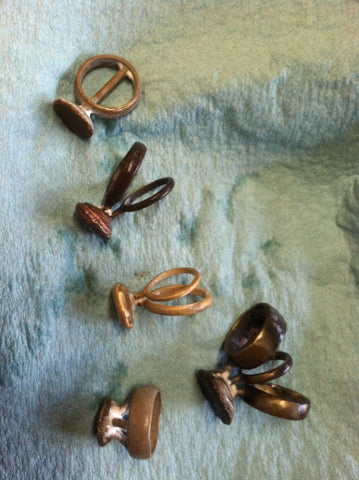
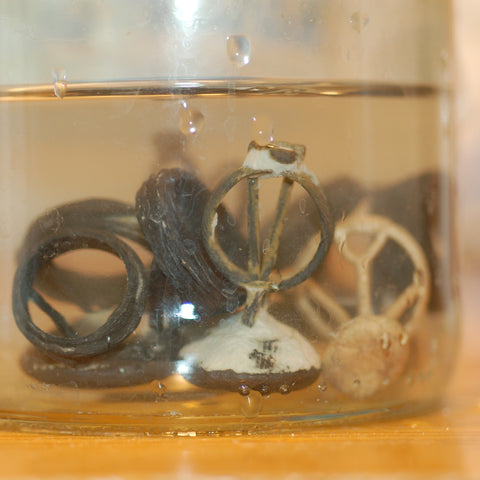
The castings above have been scrubbed clean of most of the investment, but there are still bits around the harder to reach areas. Soaking them in vinegar is a great inexpensive way to remove the investment and to clean the metal! At times I have left them in there over night or longer depending on small detail areas. And it's nice to arrive in the morning to find the metal clean! It does take longer than an ultrasonic cleaner, but if you don't have the money or the space, but have time, vinegar works just fine.
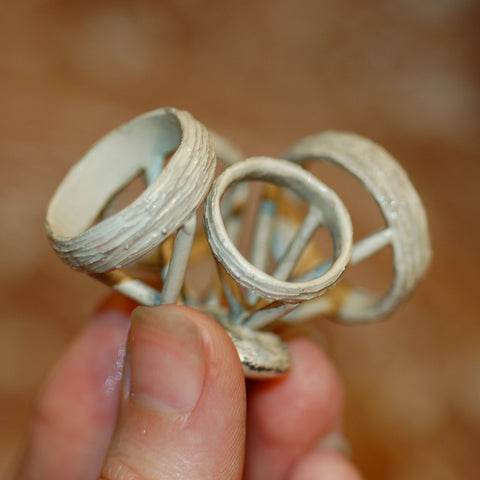
These were completely cleaned up with vinegar.
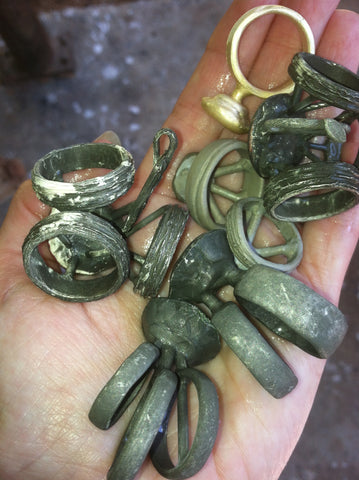
These are after the ultrasonic cleaner, before being pickled. Most of the time, I just scrub and do a quick few minutes in the ultrasonic if they need it before going in the pickle/acid.
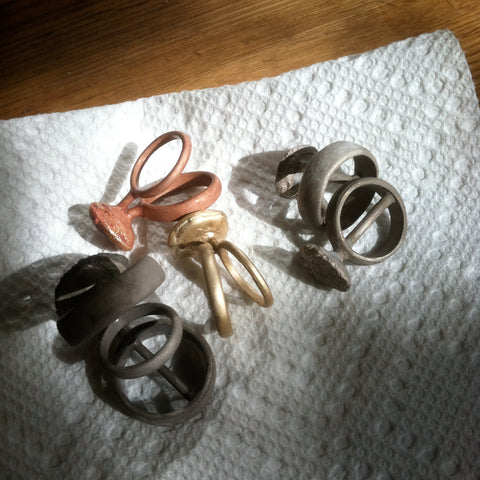
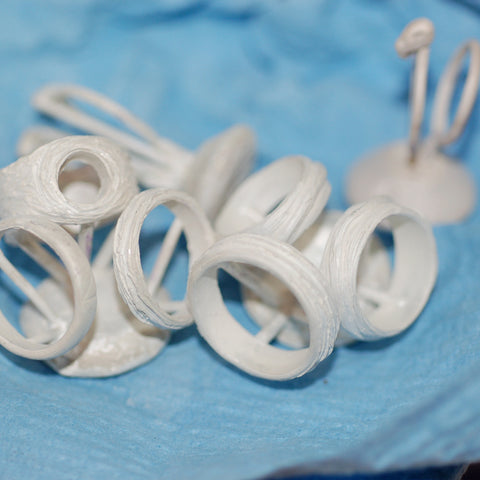
The two photos above have been completely cleaned and pickled.
And now its time to clean them up! Removing the sprues, grinding, filing, sanding, adding texture to camouflage where the sprue had been, adding a patina, and the final polish all await your piece! There are a lot of steps in between these two, lots of little abrasives and polishing and texturing, just depends on the ring in how much extra work they need for the final finish.
*update Feb 2020 - I hope to have a downloadable, expanded pdf available for purchase later this year.
If you are interested in getting your own lost wax casting set up - you can check out this basic supply list I created.

